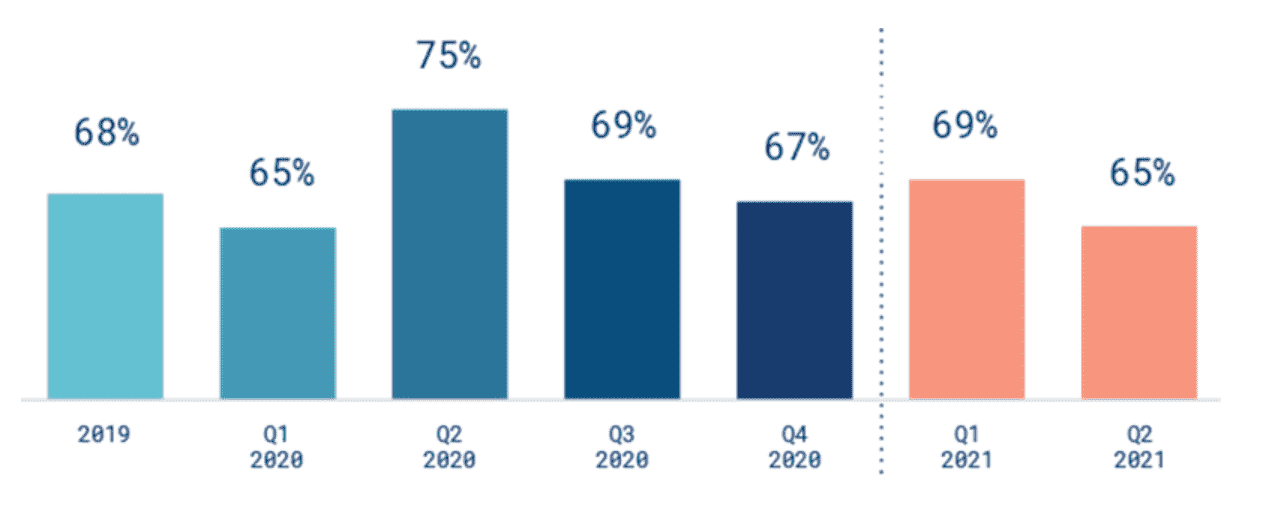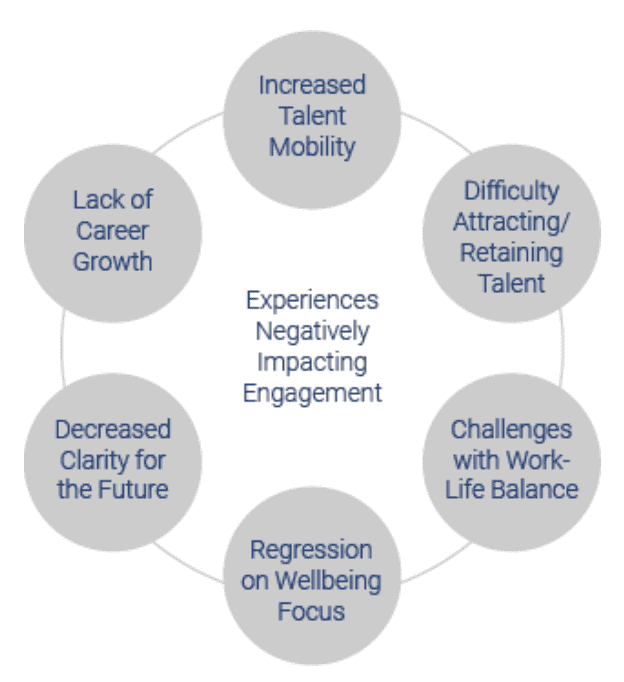After more than a year of unprecedented changes, understanding the ups and downs in employee engagement is critical in order to prepare your organization for the future. Kincentric has been analyzing employee engagement and employee eXperience (eX) trends for the past three decades across 130 markets globally. As Q2 2021 seems to constitute a turning point, our latest trend report summarizes the main learnings and suggestions to successfully manage this challenge.
A Turning Point
Despite a significant rise in Q2 2020, employee engagement has remained relatively flat across the last half of 2020 and first quarter of 2021. However, the second quarter of 2021 represents a turning point for organizations. We have now regressed below pre-COVID levels of engagement, forcing us to ask ourselves a simple question: are we really comfortable not making any progress in the employee eXperience after all we’ve gone through and all we’ve learned?
Global Employee Engagement 2020/2021

Why Did Engagement Drop in Q2 2021?
We have analyzed data from 150 unique organizations and 600K employee responses in Q2 2021 alone to better understand what drove these drops in engagement. The data helped illustrate that employees’ experiences at work are not fully discrete – they are interconnected with feedback loops in both positive and negative ways. Compared to pre-COVID (i.e., 2019), we have observed some insightful trends that illustrate the Talent Uprising taking effect:
- As many have observed in the market, resignations are increasing or predicted to increase throughout 2021 and in 2022. This is likely a mix of “catch-up” from a lack of resignations in 2020 as well as a reflection of a tougher labor market with radically shifting employee expectations. We see this reflected in our database with “Stay” scores dropping 3pts from 2019 and the first half of 2020.
- With greater employee attrition, organizations are feeling the pain of having to find and hold on to talent. Globally, only 58% of employees feel that their organization is attracting the right talent and 56% feel they are retaining the right talent needed to achieve business goals. This represents a drop of -6pts and -7pts, respectively, from 2019 (and are also both lower than Q1 2021).
- This perceived lack of having the right people in place will certainly impact employees’ work-life balance. It’s no secret employees are stressed, overworked and feeling burned out. We’ve discussed stress fatigue in previous trend reports, and we see this reflected again in Q2 2021 with a 7pt drop in perceptions of appropriate balance compared to 2019 (now at 61%). As expectations change around what “work-life balance” means, organizations will need to move beyond hybrid work considerations and start thinking about how, when and where the work gets done.
- Almost all organizations claimed a focus on wellness in 2020, but we see a strong pullback in Q2 2021 with 68% saying their organization cares about employee well-being, a 9pt drop from 2019. Perhaps most glaringly, perceptions of senior leaders demonstrating care and concern for employees regressed from a very high 85% in the first half of 2020 to 74% in Q2 2021. These movements likely reflect shifting expectations around what concepts like “well-being” and “care” mean, but it also suggests some trepidation around return-to-office plans and what the “next normal” looks like in terms of hybrid work.
- With less focus on well-being and less work-life balance while navigating a relentless global pandemic, employees are understandably uncertain about the future. Senior leaders were more visible and accessible than ever in 2020 – with 7 out of 10 employees feeling their leaders were open and honest during Q2 2020. However, perceptions of leaders have regressed recently, especially as it relates to the future. People feel leaders create less excitement for the future and receive less future direction from senior leaders (both -3pts from 2019). These responses represent broader questions employees have around the company’s future and reflect their own uncertainty about staying.
- Taking these above points together, it’s not surprising that employees are less confident in their career opportunities, with just over half (55%) seeing strong opportunities (down 6pts from 2019). A lack of career opportunities is often detrimental to engagement and frequently a top leading indicator of voluntary turnover. In a largely virtual working arrangement, ensuring employees recognize future opportunities within their organization will continue to represent a challenge for organizations.

What happens when people don’t feel excited for the future and don’t see career advancement opportunities? They are at a significantly higher risk to take their talents to another organization, only to repeat the same cycle with a different organization. One way to break this cycle is to revisit the culture – the way people interact with each other as well as the values/ beliefs/systems that impact behaviors – to ensure it is aligned to your organization’s business strategy. Organizations must invest time to assess their current culture, understand the gaps that exist between the current and desired target culture and identify the interventions necessary across leaders, talent and organizational infrastructure in order to get a company back on track.
It is interesting to note, however, that not everything dropped in Q2 2021. While employees may feel less connected to their company, they seem to feel more connected to their manager. For example, employees feel their manager creates a significantly more positive team atmosphere compared to 2019. Perhaps this suggests shifting manager competency in connecting with employees virtually. We have discussed the rise of the caring and compassionate leader before, and these recent data support this observation.
Call to Action: Reverse the Trend
When we discuss these trends with our clients, inevitably the question turns to “so what can I do about it?” While there are many factors that determine the most effective action within specific organizations, it’s always useful to think about how your specific role can help your teams move forward:
If you’re a manager
- You’ve probably been leading your team virtually for more than a year. Now, you may be talking with your team about returning to the office. This brings its own challenges that will require you to continue to be empathetic and practice active listening. Despite generally increasing perceptions of direct managers, two areas where we saw drops in Q2 2021 versus 2019 were in providing clear goals and feedback throughout the year (-3pts and -1pt, respectively). As the future of work looks to be increasingly hybrid, managers will need to ensure those who are not on-site receive appropriate and equitable coaching, feedback and role clarity.
- Ask yourself: How can I set clear goals with my team and continue to provide feedback throughout the year? Am I connecting with remote employees as frequently as I am those who are in the office? Consider having “tour of duty” conversations as part of an open, honest and caring dialogue with your direct reports.
If you’re a senior leader:
- Employees appreciated your open and transparent communication during the pandemic, but perceptions of senior leaders regressed in Q2 2021. Employees need you to help show them how you – and they – will thrive beyond 2021. Senior leaders did amazing work in 2020, particularly around open and honest communication as well as increased visibility. Many of our clients have shared incredible stories about how leaders stepped up during this crisis. However, employee perceptions have regressed in 2021 – most notably when it comes to the future. Employees are skeptical about the future vision that leaders are driving, with -3pt drops in Q2 2021.
- Ask yourself: How can I maintain visibility to employees and create excitement and confidence for our future vision? Am I role modeling the behaviors I want to see in my organization? How can I effectively communicate our strategy to convey how employees have a role in successful execution?
If you’re a CHRO:
- The past year and a half has demonstrated that transformational HR initiatives that require months or even years to deploy will not work in the future. Make the investments in HR now to achieve both short- and long-term organizational effectiveness. Many of our client conversations have illuminated challenges for the HR function as it has had to not only transform processes/moments that matter (e.g., onboarding, performance management, training, etc.) to a fully virtual environment, but also support the business through times of significant change. Organizations should be sure they fully leverage the HR Business Partner to provide optimal support to the business as well as the HR function, and ensure HR programs continue to meet the needs of the workforce.
- Ask yourself: Is my HR function equipped to support the business? Do I have the structure, processes and leaders in place to help the organization achieve its goals?
If you’re a CEO:
- Culture has become even more fundamental to business success over the past year, and many leaders have taken a fresh look at whether they have the right culture to deliver on their future business priorities. You may be in the midst of your own Talent Uprising, with increasing resignations resulting in part from people not feeling connected to the company. While there are many symptoms, the root cause may be a culture that is misaligned to the strategy and therefore fails to attract and retain your top employees.
- Ask yourself: Do we have the culture we need to achieve our business outcomes? Am I aligning culture to our strategy and bringing it to life in a way that accelerates our performance? How can I play a part in shaping our culture and turning it into a potential competitive advantage?
We are at a turning point.
After strong, positive momentum in 2020, we now find engagement lower than it was in 2019 while employees are becoming more vocal about their needs and resignations are on the rise. Organizations, however, should embrace this Talent Uprising, leveraging the learnings from the last year and a half and building on the agility and momentum gained. This shift will enable companies to drive meaningful changes in the workplace, elevating the employee eXperience to create a culture in which employees feel inspired, respected, connected and committed.

 5.0
5.0 













